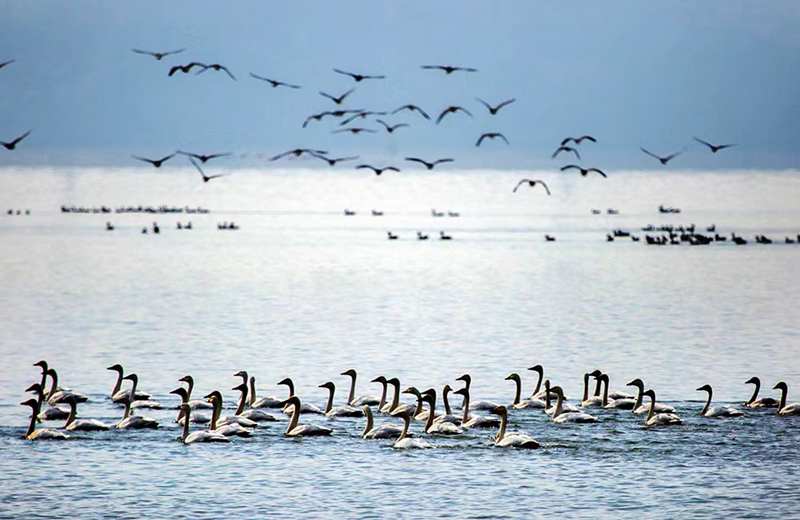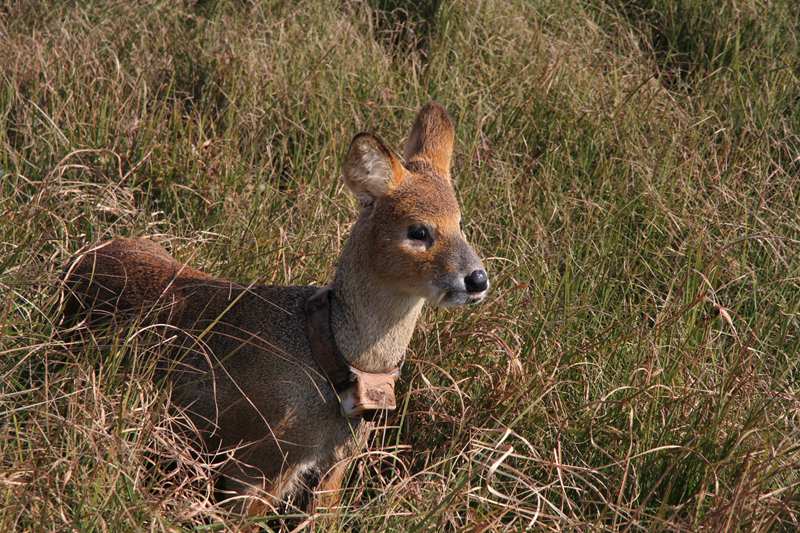“Guardians” of Poyang Lake watch over wild animals amid extreme drought
Poyang Lake in east China’s Jiangxi Province is Asia’s largest wintering ground for migratory birds. It also offers habitats and shelter for Yangtze finless porpoise and many other rare and endangered species.
Due to the extreme drought that started in July 2022 in the Yangtze River Basin, the lake has suffered the severest water shortage crisis since a hydrological record for the lake began in 1951. For a period of time, it even saw its surface area shrink by over 90 percent.

Photo shows migratory birds wintering at Poyang Lake in east China’s Jiangxi Province. (Photo/Fu Jianbin)
The extreme drought conditions have greatly reduced the living spaces for wild animals that inhabit the area. Reporters with the Jiangxi Daily recently set out to the lake to listen to the stories about the harmonious coexistence of people that watch over the lake and the animals.
For the "smiling angel"
Pan Ximing is a member of the law enforcement team for fishing management in Yongxiu county. Since late September in 2022, he has been on duty in the area.
Yangtze finless porpoise have very round heads. The shape of its mouth makes people feel as if it is smiling. Because of this, it is often dubbed as the "smiling angel.”
Poyang Lake is referred to as the “last fortress” for Yangtze finless porpoise, as half of the species’ population inhabits the waterbody.
“The water level of the lake went down too fast. We all worry that the Yangtze finless porpoise may be stranded in shallow waters,” Pan said.
On Sept. 23, when Pan patrolled the lake with his colleagues, they saw tips of some submerged rocks above the surface of the water, suggesting that the porpoise may become stranded at any moment. Since then, instead of patrolling the lake twice a week as they previously did, they have chosen to stay on duty around the clock. Aside from patrolling personally, they also resort to drones to help watch over the animal to ensure that no porpoise will go into troubles without being found.
“At the very beginning, we would eat and live on a boat, though we have built up makeshift houses on the shore area some days later,” Pan said.
In dog days, the hot sun on the shore area made them dizzy. At night, they had to suffer the mosquitos. It was so hot and stuffy that they sometimes failed to fall asleep for a whole night, he added.
Despite the difficulties, Pan and his colleagues had never thought about quitting. “We are guards of the Yangtze finless porpoise. As long as the water level does not rise to the level that is completely safe for them, we will not stop patrolling around the clock,” he said.
In the Piaoyatou area, Zhan Boshan from a law enforcement team for fishing management from Duchang county, has another important task.

Photo shows a Yangtze finless porpoise. (Photo/Xu Nanping)
Due to the large concentration of Yangtze finless porpoise in the area, they not only face the risk of being stranded but also food shortage. Following thorough discussions of experts and careful arrangements, Zhan led over 30 fishermen to the area to help dozens of the porpoise to migrate on Nov. 4.
In the operation, once a porpoise was picked up, they were immediately put onto a stretcher and then sent to a water tank, so that the breath of the animal would not be affected.
Some experts seized the time to check the heath conditions of every porpoise to ensure that they would be transported to the area with deep water safe and sound.
“The great difficulty in the work is to make them gather together. We spent over 20 days to complete this task,” Zhan said.
There are now 203 teams for fishing management in Poyang Lake. Many of them are just like Pan and Zhan who safeguard the “smiling angels” silently.
The preliminary results from the 2022 scientific investigations for the Yangtze finless porpoise, which was organized by the Ministry of Agriculture and Rural Affairs, show that the population of porpoise have increased from 1,012 in 2017.
Treat the “guests” from far away well
On Dec. 9, over 50,000 migratory birds were resting in the rice fields of Chaqi branch of Kangshan farm in Yugan county. They, together with the blue sky and the beautiful Daming Lake, one of the plate-shaped water areas in Poyang Lake that hit a very dry season after water levels goes down, comprised a vivid and harmonious ecological picture.

Photo shows migratory birds on Poyang Lake in east China’s Jiangxi Province. (Photo/Fu Jianbin)
“These little birds are smart! The number of migratory birds coming to winter went up by 20,000. They came 10 days ahead of the usual time,” said Zhang Keshun, a ranger with the Poyang Lake wetland ecological protection center of Yugan county.
To ensure that migratory birds can winter in the area safe and sound, the Yugan government paid farmers to leave the rice they planted in about 1,000 mu (67 hectares) of field so that they can work as “canteens” for the birds. Fifty mu of the rice field belongs to Zhang. For that, he was compensated more than 60,000 yuan. With no complaints for the loss at all, if he harvested the rice to sell, he expects that he could pocket another 3,000 yuan.
“It doesn’t matter. I consider that as a treat for the ’guests’ from far away,” he said.
In Duchang county’s natural reserve for migratory birds, which is over 100 kilometers away from Yugan, Li Yue, head of the reserve’s management bureau, is resorting to another approach in order to protect the migratory birds.
Duchang is an important wintering area for migratory birds in the northern part of Poyang Lake. Several plate-shaped water areas that saw large numbers of migratory birds in previous years dried up much earlier than in normal years.
“The plate-shaped water areas boast rich biodiversity resources and are paradises for migratory birds. To enliven the plate-shaped water areas, we have been busy for several months,” he said.
In late September, they carried out ecological water supplementation in a plate-shaped water area near Zhupao mountain to remediate it.
Almost two months later, the water supplemented to the plate-shaped water area near Zhupao Mountain reached over 400,000 cubic meters. Thanks to the supplementation, water levels in the area rose by over 40 centimeters, and its surface area expanded to more than 800 mu.
On Nov. 28, 2022, over 90,000 migratory birds were found to have come to winter in Duchang. The plate-shaped water area near Zhupao Mountain received over 3,000 of them, including white cranes, white-head cranes, white-naped cranes, and oriental storks.
Jiangxi Province has supplemented a total of 6.1 million cubic meters of water to plate-shaped water areas in Poyang Lake in 2022. A total of 130,000 mu of old marsh grass have been mowed, 5,370 mu of “canteen” have been set up, and 51,000 kilograms of grains have been reserved as food for migratory birds.
Safeguarding the wild animal “friends”
As many areas in Poyang Lake dried up earlier than in normal years, the marsh grass has sprouted too early and has grown old too soon. To ensure that there is enough tender grass for Anatidae migratory birds to eat, Jiangxi’s forestry department rolled out operations to mow the marsh grass.

Photo shows a water deer in grass. (Photo/Li Yankuo)
“We fixed six infrared cameras in a location where the marsh grass has been mowed. We didn’t expect that they would capture images of water deer that came to seek food just the second day. On Nov. 23, they captured water deer again,” said Li Yankuo, a professor with the Jiangxi Normal University, who is an expert on water deer.
Water deer is under grade two of national protection. Poyang Lake is one of the major distribution areas for water deer. Statistics in 2021 show that there are over 2,300 water deer around Poyang Lake.
What makes Li worry is that the water deer are very easily frightened. Once shocked, they will run in all directions to escape. Originally, they liked island covered by marsh grass, as such islands can offer them food as well as shelter. The finding of water deer in areas where the marsh grass has been mowed indicates that the drought has changed their living environment.
“Failing to find enough food, they have no choice but to take the risk to seek food here and there,” he said.
Li started researching water deer in 2015. Joining hands with the office of the demonstration program for wetland protection systems of the Global Environment Facility in Jiangxi Province, he carried out surveys for water deer in Poyang Lake in May 2020, March 2021, and September 2021. He also released nine artificially bred water deer back into nature.
With the help of satellite positioning facilities, he found that the number of water deer is rising quickly because of the increasingly intensified efforts to protect the species in Poyang Lake and the decrease in poaching activities.
Li has recently completed a plan for the monitoring and protection of water deer. He suggests carrying out regular monitoring, enhancing publicity for the animal’s protection, among other measures.
The smile of the Yangtze finless porpoise, the singing of the migratory birds that come to winter, the image of the smart water deer…. All of them have demonstrated the beauty of rich biodiversity.
Photos
Related Stories
- SW China's Yunnan makes fresh progress in protecting Asian elephants
- China revises law on wildlife protection
- Black-necked cranes spend winter in southwest China nature reserve
- In pics: migratory birds at sanctuary by Poyang Lake in east China
- Species with extremely small populations being saved in China
- Yunnan makes great progress in protecting species with extremely small populations
- World Wildlife Conference opens in Panama with call to action at crucial moment for humanity
- China publishes Atlas of Wildlife in SW China
- Freshwater lake turns into 'grassland' amid prolonged drought
- Landscape of tree seen in Jinxian section of Poyang Lake
Copyright © 2023 People's Daily Online. All Rights Reserved.









